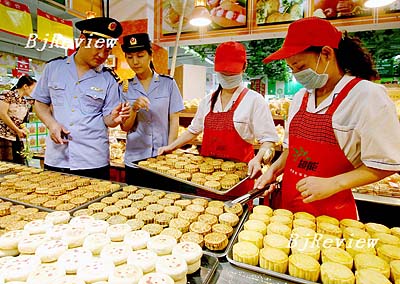|

From toothpaste contaminated by a poisonous chemical used in antifreeze to false news reports about steamed buns filled with chopped cardboard, serial food-safety scandals since May have just about dashed people's faith in the safety of Chinese foodstuffs. To prevent citizens from losing what remaining trust they have in the country's food-safety system, the government in August launched a four-month national campaign against substandard foods. Under the leadership of Vice Premier Wu Yi, renowned for her troubleshooting skills and determination, the program had destroyed 667 tons of unqualified or fake food products and removed 446 more tons from marketplaces by October 8.
Meanwhile, Chinese lawmakers have been busy working on a new food-safety draft law. On October 31, the State Council, China's cabinet, approved the draft law in principle to address the country's "weak points" in food production, processing, delivery, storage and sales. The draft law, which has been three years in the making, will be submitted to the National People's Congress, the country's legislature, for debate and adoption by year-end. It is expected to become law by the end of 2008.
The draft law attempts to close current loopholes in food-safety supervision. It says imported food and additives must meet China's national food-safety standards while food products exported from China to other countries should satisfy the compulsory requirements set by importers and pass local entry inspections and quarantines. It also specifies that local governments have legal obligations to supervise food safety in their administered regions and build fast and convenient channels to protect consumers' rights.
"I believe that this law, with its comprehensive regulations on food production, processing, consumption and supervision, will effectively improve China's food-safety situation and ensure food safety and people's health," said Li Changjiang, head of the General Administration of Quality Supervision, Inspection and Quarantine.
Beyond insufficient supervision
Zhang Yongjian, director of the Research Center for the Development and Regulation of the Food and Drug Industry under the Chinese Academy of Social Sciences, said the two biggest food-safety dangers in China are food-borne diseases and food hazards caused by fake or substandard products. More than 2,500 primary school students in Haicheng in Liaoning Province were poisoned after drinking a batch of bad soybean milk in March 2003. And 13 infants in Fuyang in central Anhui Province died after drinking milk made from substandard powder in 2004. If these cases were not enough, government leaders were further pushed to action after dozens of Beijing diners got food poisoning in 2006 after eating undercooked Amazonian snails. Between the two main food-safety threats, food-borne diseases cause more damage by far, Zhang said.
The Ministry of Health has said food poisoning is the most widespread kind of food-safety accident. Of all the food-poisoning cases, about 98.5 percent are caused by bacteria while chemical poisoning and food ingredient poisoning account for 0.7 percent and 0.8 percent, respectively.
Cao Zhongsheng, head of the Consumer Protection Department at Beijing's Administration for Industry and Commerce, said two other factors threaten food safety besides environmental pollution: chemical residues caused by the excessive use of pesticides and cattle medicine during aquatic breeding, animal or poultry farming; and food additives mixed in during processing. A notorious example is the use of Sudan Red, an industrial dye normally used to color shoe polish and plastics, by pepper-jam manufacturers to make their products more savory looking.
Most Chinese food-processing businesses are small mills or stalls that collectively employ more than 7 million workers. More than 80 percent of these small businesses hire fewer than 10 people. Their equipment is antiquated and their hygienic conditions are terrible. About 30 percent of these plants fail to meet industry standards. Most of them are located in remote city outskirts, far away from supervising authorities.
"The small size and sparse location of food-processing companies have posed a great difficulty to government supervision," Cao said.
An even bigger problem is the disorderliness of the food-processing supervision system, Cao said. China has divided food production into different phases that are supervised by different government departments. This means nearly 10 government departments are involved in guaranteeing food safety at various stages. For example, the safety of raw material is supervised by agricultural department inspectors, hygienic standards are monitored by health authorities, imported and exported foods are monitored by customs officials, and crimes undermining food safety fall under the purview of the police.
"The lack of a coordinating agency under the Central Government and overlapping functions have led to a situation where no organization is really in control," Cao said.
Moreover, various supervision authorities have promulgated different food safety standards that contradict each other. Now there's a four-hierarchy food-standard system that consists of national, industrial, local and enterprise standards. Take dried vegetables, for example. The Ministry of Health says their sulfur content cannot be greater than 0.035 mg per kg, while the Ministry of Agriculture says it must be less than 100 mg per kg. This is about 2,875 times more than what the Ministry of Health allows. Such inconsistencies have created more difficulties in food-safety supervision.
| 